One Herd's Fight for Survival

Text and Photographs by Castle McLaughlin
One of the few North American wild horse herds remaining on National Park Service (NPS) lands in the United States are in Theodore Roosevelt National Park (THRO), located in southwestern North Dakota.
Because of it's administration by the NPS, the herd is relatively little known.
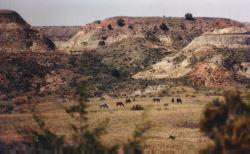 |
Unlike other U.S. federal agencies, the National Park Service (NPS) is exempt from the Wild and Free Roaming Horse and Burro Act and associated regulations, and officially regards wild horses as undesireable "exotics." As at Assateague Island National Seashore, the NPS has permitted horses to remain in the North Dakota park (THRO) because of their historic presence in the area and due to strong local support for their preservation. |
| Between 1880 and 1950, bands of wild horses were scattered throughout the rugged Little Missouri Badlands, which arc across the western half of North Dakota and are partially encompassed by two units of THRO. As elsewhere in the U.S., most wild horses in North Dakota were eradicated by federal and state agencies by 1940. |  |
When Theodore Roosevelt National Park was created near Medora, North Dakota, and then fenced ca. 1950, a few remnant harem bands were inadvertantly enclosed into the nearly 50,000 acre south unit of the park. For the next twenty years, the NPS tried to remove or destroy the horses. Many removal efforts were protested and thwarted by members of the local community, who regarded the horses as an integral aspect of regional culture and history.
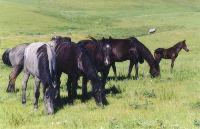 |
By 1970, THRO began to re-evaluate the removal policy. Public pressure, including both the sentiments of area residents and the growing national climate of support for the preservation of wild horses, was an important factor. Additionally, park managers became aware of historical data documenting the presence of wild horses during the open range ranching era, which the park was established to commemorate. |
| Although the park has now accepted the horses, their management during the past thirty years has been controversial. Since as an agency the NPS regards wild equines as undesireable, there is no overall wild horse policy. Individual parks that have accepted wild horses make local management decisions. At THRO, the horses are classified as "feral livestock" and are managed as an "historical demonstration herd." Unlike other federal agencies that administer wild horse herds, the park chose not to manage for an historically accurate herd. | 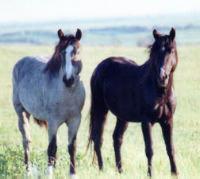 |
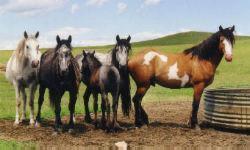 |
The dominant stallions were removed and replaced with domestic animals in order to create horses with a more modern phenotype. Most horses in the park today are the descendants of introduced stallions, which included Quarter Horses, an Arabian, and a part-Shire bucking horse. |
Round-ups are staged every few years and "excess" animals are sold at public auction. Current management goals are to maintain a population of less than 140 animals. Since the NPS is exempt from federal laws protecting wild horses, there are no regulations governing the conduct of round-ups, and no restrictions on resulting sales. In the past, most captured horses have been sold for slaughter. The next round-up is scheduled for the fall of 2000.
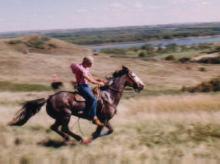 |
The original badlands horses would have disappeared if not for the efforts of two brothers from Linton, North Dakota. Leo Kuntz, Jr. and Frank Kuntz began buying a few individual horses from park sales in the late 1970s. After those horses proved themselves in cross-country races and their "old-fashioned" appearance drew comments from other horsemen, the brothers began investigating the history of the park horses. |
| Photographs of the Sioux mares owned by de Mores and the HT bear a striking resemblance to some of the horses that were in the park through the 1980s, and the Kuntz brothers believe that the Sitting Bull stock influenced the badlands herds. Other ranch horses used in the area between 1880-1940 and which may have impacted the wild herds were also of the "Indian pony," Spanish, and early Quarter Horse type. | 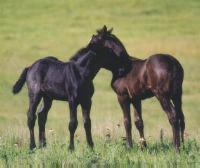 |
During the mid-1980s, the Kuntz brothers began buying as many park horses as they could, in order to save them from slaughter. They have since devoted their lives to maintaining the horses on their family farm outside of Linton, while strenously but unsuccessfully lobbying the NPS to reinstate the "old lines" into the park. They have also named the once-wild animals "Nokota horses," and have started a breed registry. In recognition of the role that early ranch and Indian horses played in state history, North Dakota legislators passed a bill in 1988 declaring the Nokota the "honorary state equine." With advice from Dr. Phillip Sponenberg, an expert on colonial Spanish horses, Leo Kuntz Jr. has been selectively breeding to maintain the Spanish and Indian horse phenotype. The horses are allowed as much freedom as possible, in order to maintain their natural behavior and organization.
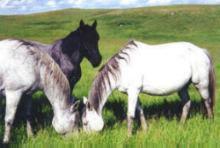 |
In 1999, the Kuntz family and their supporters founded the Nokota Horse Conservancy, Inc., which was recently granted non-profit status. The primary goal of the conservancy is to acquire land for a sanctuary. Should they succeed, the horses will have found refuge after more than a century of persecution. |
| This article is
courtesy of The Nokota Horse Conservancy www.nokotahorse.org Please click here to learn more about this endangered breed All photographs used in this essay, excepting one of wild horses in Theodore Roosevelt National Park, and one of Leo Kuntz, Jr. in a horse race, were taken at the Kuntz family ranch in Linton, North Dakota. |